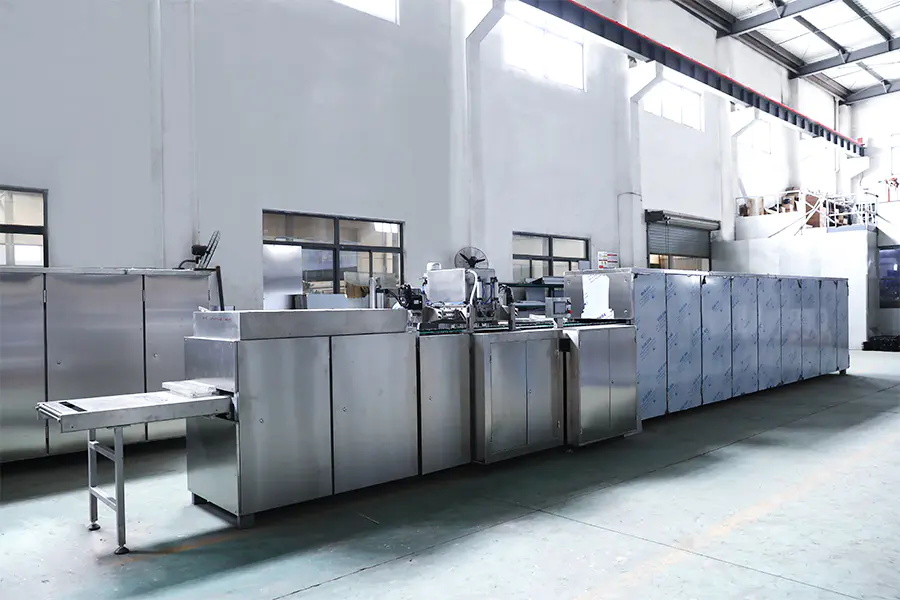The chocolate pouring machine is based on the principle of fluid dynamics. Through a precise mechanical structure and temperature control system, it converts molten chocolate raw materials into solid molded products. Its workflow can be broken down into three core links:
The built-in melting system of the equipment uses hot water circulation insulation technology to heat the solid chocolate raw materials to a precise temperature range of 35℃-45℃ to ensure that the raw materials are fluid and have stable viscosity. The quantitative delivery module adopts a piston metering device. The filling metering range of each piston can cover 3-13 grams to meet the production needs of products of different specifications.
The molten chocolate is injected into a customized mold through the pouring head. The mold specifications are usually standard sizes of 275mm×175mm×20mm. The vibration leveling mechanism uses high-frequency micro-vibration to evenly spread the chocolate liquid surface and eliminate bubbles to ensure the smoothness of the product surface.
The molded chocolate needs to be quickly cooled in a low-temperature environment of 5℃-8℃. This process is achieved by a circulating cold air system or a tunnel cold channel. The demoulding process uses a cylinder-driven die-pulling mechanism to completely peel the solid chocolate from the mold and send it to the subsequent packaging process via a conveyor belt.
As an automated equipment that integrates machinery, electricity and control, the technical parameters of the chocolate pouring machine directly reflect its production capacity and process accuracy:
Production efficiency: The production capacity of a single shift (8 hours) can reach 1-3 tons, meeting the large-scale production needs of small and medium-sized enterprises.
Temperature control accuracy: The hot water circulation system can achieve constant temperature control of ±0.5℃ to avoid the quality degradation of chocolate raw materials due to temperature fluctuations.
Quantitative accuracy: The error range of the piston metering device is controlled within ±1% to ensure that the net content of the product meets regulatory standards.
Energy consumption performance: The power of the whole machine is usually between 17.4kW-28.23kW. Some energy-saving equipment can reduce energy consumption by more than 20% by optimizing the refrigeration system and heat recovery technology.
Sanitary standards: The fully enclosed production design meets food-grade hygiene requirements, and key components are made of 304 stainless steel for easy cleaning and disinfection.
With the diversification of market demand, chocolate depositing machines have derived a number of technological breakthroughs based on traditional functions:
For complex products such as sandwich chocolate and two-color chocolate, the equipment integrates a template flipping mechanism and a two-way operation system to achieve synchronous pouring and composite molding of multi-layer chocolate liquid. For example, in the production of sandwich chocolate, the system first injects the bottom layer of chocolate, flips the template after vibration leveling, and then injects the sandwich layer and the surface layer of chocolate, and finally presses the two templates together through the mold clamping mechanism.
Modern depositing machines can be seamlessly connected with baking, demolding, packaging and other processes to form a full-process automated production line. For example, in the chocolate bean production line, the poured product is cooled and demolded, and then directly enters the vibration screening machine and packaging machine, realizing "zero manual intervention" from raw materials to finished products.
Through modular design, the equipment can quickly replace molds and pouring heads of different specifications, supporting the flexible production of various forms of products such as chocolate blocks, chocolate bars, chocolate candies, etc. Some models also support the cleaning in place (CIP) function to reduce mold replacement time.
Chocolate depositing machines play multiple roles in the food industry:
In chocolate manufacturing factories, depositing machines can replace traditional manual depositing processes, increase single-shift production capacity to tons, and reduce defective rates through standardized operations. For example, when producing chocolate with fillings, the equipment can ensure that the thickness uniformity error of the filling layer is less than 0.2mm.
In high-end chocolate production lines, chocolate depositing machines can achieve precise pouring of special-shaped molds through parametric programming to meet the personalized needs of scenes such as holiday gifts and wedding customization. For example, by adjusting the motion trajectory of the depositing head, special-shaped chocolates such as heart-shaped and star-shaped can be produced.
In the product development stage, the small-batch production capacity of the depositing machine (single pouring volume can be as low as 100 grams) supports R&D personnel to quickly verify new formulas and processes and shorten the R&D cycle. For example, when testing the recipe of nut chocolate, the uniformity of nut distribution can be optimized by adjusting the pouring temperature and vibration frequency.


 中文简体
中文简体 English
English Français
Français عربى
عربى


